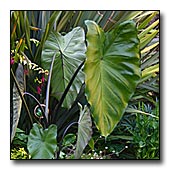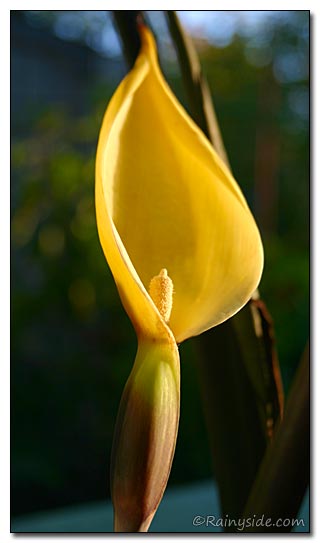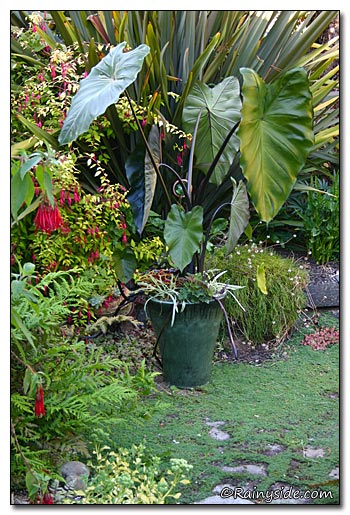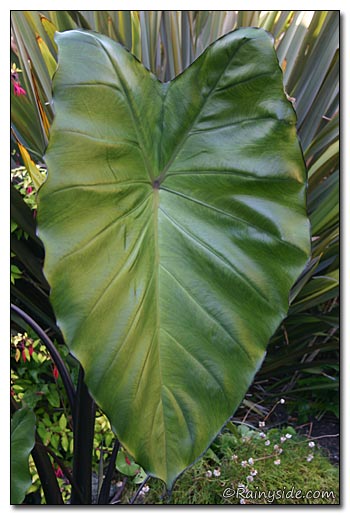Colocasia esculenta 'Fontanesii'
BLACK STEM ELEPHANT EAR
Family: Araceae
Pronounced: kol-oh-KAY-see-uh es-kew-LEN-tuh

Quick Jumps
Growing Guide
Rainy Side Notes
GROWING GUIDE
Origin:
Garden.
Plant Group:
Bulbs.
Hardiness:
Sunset zones 12, 16-24, H1, H2.
USDA zones: 8-11.
Heat zones: 12-10.
Mature size:
Height: 5-6 feet (1.5-2 m).
Width: 3 feet (90 cm).
Flowering period:
September.
Flowering attributes:
The calla lily like flowers have a yellow spathe surrounding a yellow spadix.
Leaf attributes:
Large (2-3 feet), arrow-shaped, glossy, green leaves top deep purple, succulent stalks.
Growth habit:
Upright.
Light:
Full sun to partial shade.
Soil:
Moist to wet, fertile, humus rich soil.
Propagation Methods:
Divide in early spring or late winter.
Pruning Methods:
Prune off dead leaves throughout the growing season to keep the plant looking good.
Pests and Diseases:
Aphids and white flies can be a problem when wintering plants over in the greenhouse.
Rainy Side Notes

Its common name, black stem elephant ear, is all about the plant's dark purple stems, so dark they appear to be black. Colocasias are often called elephant ears; however, when I lived in Hawaii, we knew these evergreen, big-leaf plants as taro. Grown as a vegetable food, taro must be cooked or steeped in water to remove the toxic calcium oxalate before it's eaten. Many people, including myself, don't care for the bland, starchy taste unless they ate poi (made from the taro plant) as a staple food when they were children.
The tubers are hardy in USDA zones 8-11, yet Sunset's Western Garden book does not rate them hardy in the maritime Northwest. However, a local nursery owner advised me to use a two-year-old plant, grown in humus-rich soil and mulched heavily, and see it survive planted in the ground in Sunset Zone 5. I'm skeptical about the survival rate in our climate, but it may be worth experimenting. I grow mine in containers and winter them over in the greenhouse.
The flower gives it away; this genus is in the aroid family—Araceae. The yellow flower resembles many in the family, such as our much-maligned Northwest native skunk cabbage, Lysichiton americanus. Unlike our native son, this colocasia flower has the scent of papaya, according to Tony Avent of Plant Delights Nursery in North Carolina. I missed a fragrance on my plant but might have been too nervous to sniff around a skunk-cabbage-like flower. Next time it flowers, I will gingerly inhale its odor, just in case Avent is pulling our collective legs about the reward of a papaya scent after a deep inhale.
To grow the tallest stems and larger leaves, give them constant moisture and humus-rich soil, and lightly fertilize once a month. You can grow these bulbs in containers, plant them in a pot, and sink them into a water garden. They add a tropical flair wherever you plant them. They send out runners with a small leaf on the end, which appears to be stems flopping over. Use the runners to propagate more plants by allowing them to coil around the inside of the pot until fully ripe. Divide the suckers out, plant in a one-gallon pot, and overwinter in a sunny, frost-free space. Slowly acclimate outdoors after the last frost.
The sap may irritate the skin, so handle it with care.


Photographed in author's garden.
A Pacific Northwest Plant of the Week (2013)

Gardening for the Homebrewer: Grow and Process Plants for Making Beer, Wine, Gruit, Cider, Perry, and More
By co-authors Debbie Teashon (Rainy Side Gardeners) and Wendy Tweton
Copyright Notice | Home | Search | Bulbs

